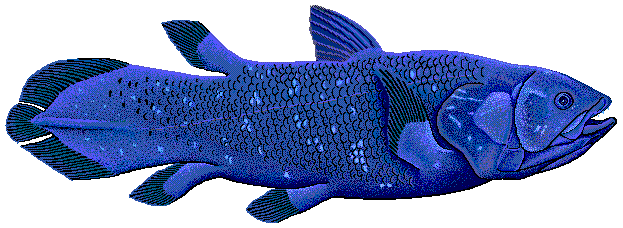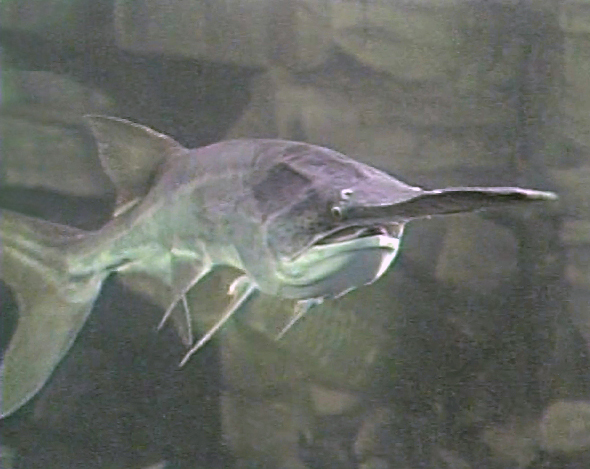|
Acipenseriform
Acipenseriformes is an order of basal ray-finned fishes that includes living and fossil sturgeons and paddlefishes (Acipenseroidei), as well as the extinct families Chondrosteidae and Peipiaosteidae. They are the second earliest diverging group of living ray-finned fish after the bichirs. Despite being early diverging, they are highly derived, having only weakly ossified skeletons that are mostly made of cartilage, and in modern representatives highly modified skulls. Description The axial skeleton of Acipenseriformes is only partially ossified, with the majority of the bones being replaced with cartilage. The notochord, usually only found in fish embryos, is unconstricted and retained throughout life. The premaxilla and maxilla bones of the skull present in other vertebrates have been lost. While larvae and early juvenile acipenseriforms have teeth, the adults are toothless, or nearly so. The infraorbital nerve is carried by a series of separate canals, rather than be ... [...More Info...] [...Related Items...] OR: [Wikipedia] [Google] [Baidu] |
Acipenseridae
Sturgeon (from Old English ultimately from Proto-Indo-European language, Proto-Indo-European *''str̥(Hx)yón''-) is the common name for the 27 species of fish belonging to the family Acipenseridae. The earliest sturgeon fossils date to the Late Cretaceous, and are descended from other, earlier Acipenseriformes, acipenseriform fish, which date back to the Early Jurassic period, some 174 to 201 million years ago. They are one of two living families of the Acipenseriformes alongside paddlefish (Polyodontidae). The family is grouped into five genera: ''Acipenser'', ''Huso'', ''Scaphirhynchus,'' ''Sinosturio'', and ''Pseudoscaphirhynchus''. Two species (''Adriatic sturgeon, H. naccarii'' and ''Dabry's sturgeon, S. dabryanus'') may be extinct in the wild, and one (''Syr Darya sturgeon, P. fedtschenkoi'') may be entirely extinct. Sturgeons are native to subtropical, temperate and sub-Arctic rivers, lakes and coastlines of Eurasia and North America. A Maastrichtian-age fossil found i ... [...More Info...] [...Related Items...] OR: [Wikipedia] [Google] [Baidu] |
Eochondrosteus
''Eochondrosteus'' (meaning "dawn '' Chondrosteus''") is a genus of extinct marine actinopterygian (ray-finned fish), comprising one species, ''E. sinensis'' ( monotypy) from the Early Triassic strata in Gansu Province (Beishan Hills), China (previously interpreted as Permian in age). It is suggested to be the most basal acipenseriform (sturgeon Sturgeon (from Old English ultimately from Proto-Indo-European language, Proto-Indo-European *''str̥(Hx)yón''-) is the common name for the 27 species of fish belonging to the family Acipenseridae. The earliest sturgeon fossils date to the ..., paddlefish, and their fossil relatives). It was originally described in 2005, and then redescribed in 2020 in Chinese. Other authors have considered the placement of ''Eochondrosteus'' within the Acipenseriformes as tentative, or have expressed doubt about its placement in the order References Acipenseriformes {{Triassic-fish-stub Monotypic prehistoric ray-finned fish gene ... [...More Info...] [...Related Items...] OR: [Wikipedia] [Google] [Baidu] |
Paddlefish
Paddlefish (family Polyodontidae) are a family of ray-finned fish belonging to order Acipenseriformes, and one of two living groups of the order alongside sturgeons (Acipenseridae). They are distinguished from other fish by their elongated rostra, which are thought to enhance electroreception to detect prey. Paddlefish have been referred to as " primitive fish" because the Acipenseriformes are among the earliest diverging lineages of ray-finned fish, having diverged from all other living groups over 300 million years ago. Both living and fossil paddlefish are found almost exclusively in North America and China. Eight species are known: Six of those species are extinct, and known only from fossils (five from North America, one from China), one of the extant species, the American paddlefish (''Polyodon spathula''), is native to the Mississippi River basin in the U.S. The other is the Chinese paddlefish (''Psephurus gladius''), which was declared extinct in 2022 following a ... [...More Info...] [...Related Items...] OR: [Wikipedia] [Google] [Baidu] |
Acipenser Ruthenus 1
''Acipenser'' is a genus of sturgeons, containing three species native to freshwater and estuarine systems of eastern North America and Europe. It is the type genus of the family Acipenseridae and the order Acipenseriformes. Taxonomy Prior to 2025, ''Acipenser'' contained almost all species in the Acipenseridae outside of ''Huso'' and the "shovelnose" sturgeons (''Scaphirhynchus'' and '' Pseudoscaphirhynchus''). However, such a placement is now known to be paraphyletic with respect to the other genera, and these species have since been split into ''Huso'' and '' Sinosturio''. ''Acipenser'' in the strict sense ('' sensu stricto'') has been redefined with only 3 species. This is an ancient genus, with phylogenetic evidence suggesting that it is the most basal sturgeon genus, having diverged from other sturgeons during the Early Cretaceous period. Several fossil species known as far back as the Late Cretaceous, with the fossils of two species ('' A. praeparatorum'' and '' A. amnis ... [...More Info...] [...Related Items...] OR: [Wikipedia] [Google] [Baidu] |
Chondrosteidae
Chondrosteidae is a family (biology), family of extinct marine actinopterygian fishes, known from the Early Jurassic of Europe. They are closely related to modern Sturgeon, sturgeons and paddlefish of the order Acipenseriformes, and are either placed as part of that order or the separate order Chondrosteiformes within the Chondrostei. Three genera are known, ''Chondrosteus'', ''Gyrosteus'', and ''Strongylosteus''. Included species were of large size, with body lengths ranging from up to . Their skeleton was largely made up of bones (unlike living chondrosteans), but ossification was reduced compared to other ray-fins. See also * Prehistoric fish * List of prehistoric bony fish References External links * Acipenseriformes Fossils of Great Britain Jurassic fish of Europe Jurassic bony fish Prehistoric ray-finned fish families {{Jurassic-fish-stub ... [...More Info...] [...Related Items...] OR: [Wikipedia] [Google] [Baidu] |
Actinopterygii
Actinopterygii (; ), members of which are known as ray-finned fish or actinopterygians, is a class (biology), class of Osteichthyes, bony fish that comprise over 50% of living vertebrate species. They are so called because of their lightly built fish fin, fins made of webbings of skin supported by radially extended thin bony spine (zoology), spines called ''lepidotrichia'', as opposed to the bulkier, fleshy lobed fins of the sister taxon, sister clade Sarcopterygii (lobe-finned fish). Resembling folding fans, the actinopterygian fins can easily change shape and wetted area, providing superior thrust-to-weight ratios per movement compared to sarcopterygian and chondrichthyian fins. The fin rays attach directly to the proximal or basal skeletal elements, the radials, which represent the articulation (anatomy), articulation between these fins and the internal skeleton (e.g., pelvic and pectoral girdles). The vast majority of actinopterygians are teleosts. By species count, they domi ... [...More Info...] [...Related Items...] OR: [Wikipedia] [Google] [Baidu] |
American Paddlefish
The American paddlefish (''Polyodon spathula''), also known as a Mississippi paddlefish, spoon-billed cat, or spoonbill, is a species of ray-finned fish. It is the last extant taxon, living species of paddlefish (Polyodontidae). This family is most closely related to the sturgeons; together they make up the order (biology), order Acipenseriformes, which are one of the most Basal (phylogenetics), primitive living groups of ray-finned fish. Fossil records of other paddlefish species date back 125 million years to the Early Cretaceous, with records of ''Polyodon'' extending back 65 million years to the early Paleocene. The American paddlefish is a smooth-skinned freshwater fish with an almost entirely cartilage, cartilaginous skeleton and a paddle-shaped rostrum (anatomy), rostrum (snout), which extends nearly one-third its body length. It has been referred to as a freshwater shark because of its heterocercal tail or caudal fin resembling that of sharks, though it is not closely rel ... [...More Info...] [...Related Items...] OR: [Wikipedia] [Google] [Baidu] |
Peipiaosteidae
Peipiaosteidae is an extinct family of fish, known from the Late Jurassic and Early Cretaceous of Asia. They are members of Acipenseriformes, related to sturgeons (Acipenseridae) and paddlefish (Polyodontidae). Fossils have been found in freshwater deposits in China, Russia, Kazakhstan, and Mongolia. They are generally considered either the earliest diverging group of Acipenseriformes, or the sister group to the clade containing Acipenseridae and Polyodontidae. At least '' Yanosteus'' was likely to have been piscivorous, based on a specimen of '' Lycoptera'' found in the mouth of one specimen. Taxonomy After. * '' Stichopterus'' Reis, 1910 ** ''Stichopterus woodwardi'' Reis, 1910 Turgen Formation, Russia, Early Cretaceous ** ''Stichopterus popovi'' Jakovlev, 1977 Gurvan-Eren Formation, Mongolia, Early Cretaceous (Aptian) ** Indeterminate remains are known from the Early Cretaceous Murtoi Formation, Russia.A. O. Averianov and P. P. Skutschas. 2009. Additions to the Early Cret ... [...More Info...] [...Related Items...] OR: [Wikipedia] [Google] [Baidu] |
Atlantic Sturgeon
The Atlantic sturgeon (''Acipenser oxyrinchus'') is a large species of sturgeon native to both sides of the Atlantic Ocean, and associated river basins. It is a member of the family Acipenseridae, and, along with other sturgeon, it is sometimes considered a living fossil. The main range of the Atlantic sturgeon is in eastern North America, extending from New Brunswick, Canada, to the eastern coast of Florida, United States. A highly endangered Disjunct distribution, disjunct population occurs in the Baltic region of Europe (today only through a reintroduction project). The Atlantic sturgeon was in great abundance when the first European settlers came to North America, but has since declined due to overfishing, water pollution, and habitat impediments such as dams. It is considered threatened, endangered, and even locally extinct in many of its original habitats. The fish can reach 60 years of age, in length and over in weight. Taxonomy Alongside its relative the European se ... [...More Info...] [...Related Items...] OR: [Wikipedia] [Google] [Baidu] |






